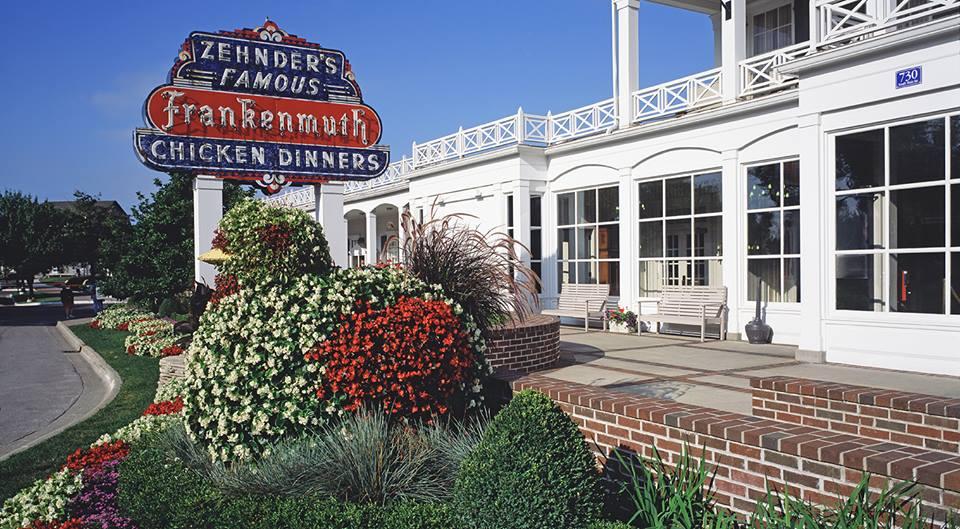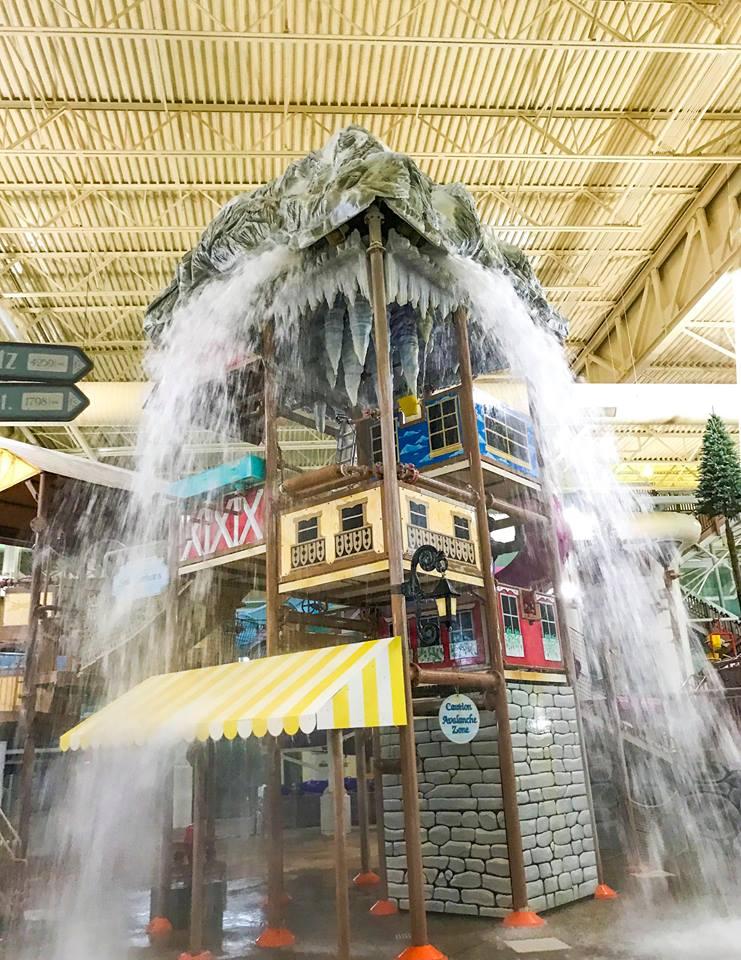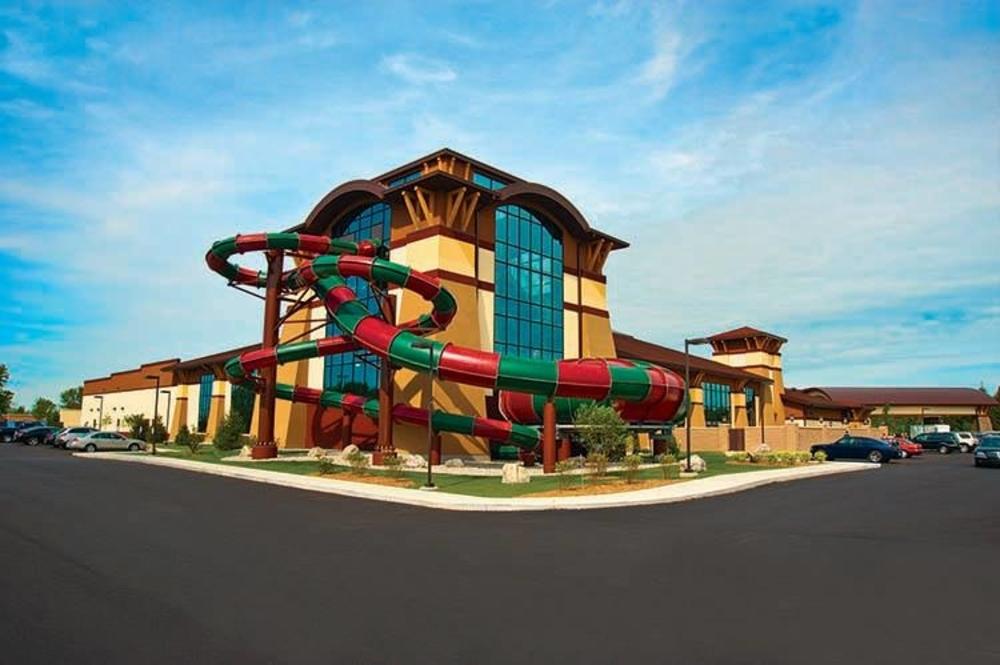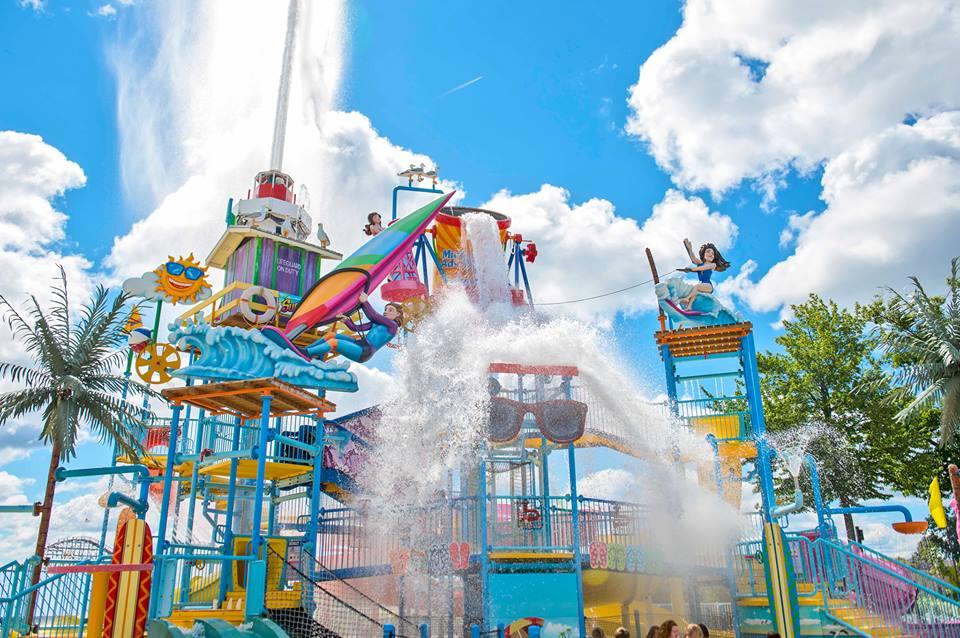In This Article
Craving a splash-filled day with the kids or friends? Dive into these top Michigan water parks where epic slides, wave pools, and lazy rivers guarantee hours of refreshing fun!
Highlights:
- Slide down towering water rides at Avalanche Bay Indoor Waterpark in Boyne Falls.
- Float along the lazy river at WildWater Adventure in Muskegon.
- Play at Zehnder’s Splash Village Indoor Waterpark in Frankenmuth.
- Enjoy splash zones and family pools at Turtle Cove Family Aquatic Center in Belleville.
- Cool off at Water Warrior Island inflatable water park in Brighton.
Unique Michigan Water Parks
1. Zehnder's Splash Village
I like:
"Float the lazy river and ride water slides on a fun family getaway."

© Zehnder's Splash Village
One of the country’s few indoor waterparks to offer two very different sections is Zehnder's Splash Village, which even features a waterpark with a retractable roof. Zehnder’s consists of more than 50,000 square feet of water fun and is one of the largest indoor waterpark’s in the state of Michigan. Guests can experience a super loop drop water slide, a six-story raft ride for the entire family, the Action River, the Dumping Bucket, a play area known as Splash Landing, a zero-entry pool full of activities, a lazy river, and tube slides measuring four stories along with several other attractions.
1365 S Main St, Frankenmuth, MI 48734, Phone: 844-330-1715
2. Great Wolf Lodge in Traverse City
I recommend:
"Splash indoors and enjoy themed suites on a kids-friendly trip."

© Courtesy of Tropical studio - Fotolia.com
Great Wolf Lodge in Traverse City, Michigan, offers affordable family fun that doesn’t hurt the family budget. The resort and indoor waterpark boasts that it offers the best value for family entertainment. Among the many water attractions, the indoor waterpark includes several water slides, such as the River Canyon Run, Alberta Falls, and Totem Falls. There is also a water fort tree house, and the Whooping Hollow designed for younger guests. The Manitoba Tubs offer a relaxing soak in warm water. In addition to the large indoor waterpark, Great Wolf Lodge features options for dining, shopping, and other attractions.
3575 N. US Highway 31 South, Traverse City, MI 49684, Phone: 231-941-3600
3. Avalanche Bay Indoor Waterpark
I love:
"Zoom down slides and soak in hot tubs on an exciting winter escape."

© Avalanche Bay Indoor Waterpark
Avalanche Bay Indoor Waterpark is 88,000 square feet of crazy water-filled family fun. The indoor waterpark is the largest of its kind in the state of Michigan, offering guests massive amounts of fun with water for people of all ages. The waterpark is conveniently situated in the center of Boyne Mountain Resort, and the “wet and wild” park is a constant 84°F degrees, allowing guests to enjoy all of the water fun year round. The latest and most thrilling new attraction at Avalanche Bay is the Big Couloir. Riders start out in a launch capsule that is angled 10 degrees from vertical for a really steep drop.
1 Boyne Mountain Rd, Boyne Falls, MI 49713, Phone: 855-688-7046
4. Soaring Eagle Waterpark and Hotel
I enjoy:
"Play in splash zones and relax nearby on an affordable weekend."

© Soaring Eagle Waterpark and Hotel
Guests of the Soaring Eagle Waterpark and Hotel can start their water-filled fun by sliding through Loon’s Loop, the park’s three-story water slide, as they are sent turning and twisting at rapid speeds aboard inner tubes. Riders are then spun in a 360-degree bowl before dropping into the Little Beaver’s Bend River. Makwa’s Mountain, another attraction at the waterpark, is anything but a typical rock climbing wall. The wall is heart-pounding, helmet-free, harness-free excitement. Visitors ascend the giant wall to 8 feet above the park’s deepest pool. From the top it is a free-fall back into the deep pool.
5665 E. Pickard Rd, Mt. Pleasant, MI 48858, Phone: 877-232-4532
Michigan Water Parks for Younger Kids
5. Red Oaks Waterpark
I like:
"Slide, spray, and swim outdoors on a fun summer trip."

© Courtesy of valiza14 - Fotolia.com
Red Oaks Waterpark offers plenty of water fun for children of all ages. Children especially love the waterpark’s Soak Station, a water playground designed for kids, including 68 fun features like a 8-foot tipping water-filled bucket, bubbler jets, slides and curtains, and water jets. The Spray and Play area is geared towards younger children and features bubblers and water jets at a depth of zero. Guests of all ages can grab an inner tube and float down the 990-foot moving River Ride. Other attractions at Red Oaks Waterpark include the Terrific Tides wave pool and the Triple Turn water slide.
1455 E. Thirteen Mile Rd, Madison Heights, MI 48071, Phone: 248-858-0918
6. Michigan's Adventure
I Recommend:
"Ride thrilling coasters and cool off in the waterpark on an exciting day."

© Michigan's Adventure
Michigan's Adventure
is the largest amusement park, as well as waterpark, in the state of Michigan. The amusement part features seven different roller coasters, such as the Thunderhawk and the Shivering Timbers. The Wild Water Adventure waterpark has 15 different water attractions and is the state’s largest outdoor waterpark. Guest can have their own beach party with a drenching bucket, water wheels, water slides, spray guns, and more. Half Pint Paradise is a splash pad and slide attraction for younger guests and their families. The waterpark also has more extreme slides for guests to enjoy, such as the Funnel of Fear.
4750 Whitehall Rd, Muskegon, MI 49445, Phone: 231-766-3377
7. Splash Universe
I like:
"Enjoy indoor water fun and stay cozy year-round on a kids-focused trip."

© Courtesy of Dmitry Perov - Fotolia.com
Splash Universe is an indoor waterpark located in the town of Dundee. The massive indoor waterpark features more than 100,000 gallons of water excitement for the entire family. The waterpark resort is open throughout the entire year, offering family experience full of fun any time of the year in Dundee, Michigan. There are plenty of attractions to entertain guests at Splash Adventure, from the Water Adventure Tree House to the thrilling Goldmine Adventure Water Slide. River Raison, the waterpark’s lazy river, provides a relaxing ride down a slow current. There are several other water-filled and fun attractions as well.
100 Whitetail Dr, Dundee, MI 48131, Phone: 734-606-0149
8. Waterford Oaks
I enjoy:
"Race down slides and enjoy the wave pool on a cheap summer outing."

© Courtesy of olgasparrow - Fotolia.com
Waterford Oaks, managed by the Parks and Recreation Department of Oakland County, provides several water attractions for visitors to enjoy during the summer months. The tropical wave pool at the outdoor waterpark features bubbler fountains and palm trees near the pool’s shore. Other attractions at the waterpark include the water playground children with over 30 different interactive features and the park’s group raft ride, which is three stories tall. All of the pools at Waterford Oaks waterpark are heated. There are also concessions, picnic areas, and grills available for guests to use, along with tubes, lounge chairs, and a bathhouse featuring lockers and showers.
1702 Scott Lake Rd, Waterford, MI 48328, Phone: 248-858-0918
I get asked this a lot so I decided to include it:
-
Question: What types of waterparks are available in Michigan?
Answer: Michigan has numerous waterparks, offering a variety of water-filled fun through regular outdoor waterparks and indoor waterparks.
-
Question: Can people enjoy waterparks in Michigan year-round?
Answer: With many indoor waterparks in the state, residents and tourists can enjoy water slides, splashpads, wave pools, and much more anytime during the year.
-
Question: What activities do Michigan waterparks offer for visitors?
Answer: These waterparks provide something for nearly everyone, from water playgrounds for young children to lazy rivers and exhilarating water slides.
-
Question: What additional features do some indoor waterparks in Michigan offer?
Answer: Several indoor waterparks also provide other attractions, dining, and accommodations.
Best Time to Visit Water Parks in Michigan
- June to August – Peak summer season with warm temps, perfect for water adventures.
- July – Busiest month with vibrant summer vibes and extended park hours.
- May & September – Shoulder season offering mild temps and fewer crowds.
- April & October – Cooler months with limited outdoor park openings and special events.
- Early June – Ideal time for pleasant weather and shorter wait times before summer rush.
Map:
How did I do?
Is the article too broad, too narrow, or just right ? Do you like the presentation of photos and text? Let me know in the comments! If you want to see more in this location, I can put it on my editorial calendar. I'm listening!
Plan Your Trip










